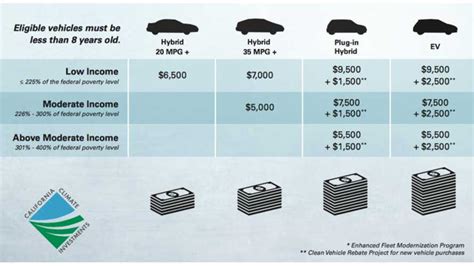As the world grapples with the implications of climate change, the transition to electric vehicles (EVs) has become a focal point for many governments. Among the leaders in this effort is California, where a series of electric vehicle rebate programs are transforming the transportation landscape. This article explores how these rebates are fostering a greener future, the implications for California’s economy, and how they are influencing the global shift towards sustainable transportation.
The California EV Rebate Program
California’s commitment to reducing greenhouse gas emissions extends beyond regulatory measures; it encompasses financial incentives as well. The California Clean Vehicle Rebate Project (CVRP) was established to promote the adoption of zero-emission vehicles (ZEVs) across the state. Through this program, consumers can receive rebates that significantly reduce the cost of purchasing or leasing an electric vehicle.
These rebates vary based on the vehicle’s price and the buyer’s income level. Recent eligibility changes have prioritized low- and middle-income families, ensuring that EVs are accessible to all demographics.
Impact on Green Transportation
The deployment of EV rebates has resulted in a substantial increase in electric vehicle sales throughout California. In recent years, the state has reported that nearly 15% of all new car sales are electric. A driving factor for this increase can be attributed to the significant reductions in upfront costs due to rebates.
Moreover, electric vehicles have a lower total cost of ownership compared to traditional internal combustion engine vehicles. With savings on maintenance and fuel costs, consumers often find that the long-term benefits of adopting green transportation outweigh any initial investments.
Environmental Benefits
The broader implications of the EV rebates extend beyond just sales figures. By incentivizing the switch to electric vehicles, California is playing a crucial role in reducing air pollution and greenhouse gas emissions. EVs produce no tailpipe emissions, and as the electricity grid continues to become cleaner with renewable energy sources, the overall carbon footprint of driving an electric vehicle will decrease even further.
In 2020 alone, electric vehicles accounted for a substantial drop in carbon emissions from the transportation sector, contributing to cleaner air and a healthier environment for all Californians.
Economic Growth and Job Creation
Alongside environmental benefits, California’s electric vehicle rebate programs are fostering economic growth. The demand for electric vehicles has spurred job creation within the manufacturing and technology sectors. Companies involved in the production of EVs and charging infrastructure have seen rapid growth, offering various employment opportunities outpacing traditional automotive industries.
Furthermore, investments in charging stations and related infrastructure are vital components of California’s green transportation initiative. These developments not only enhance the usability of electric vehicles but also stimulate the local economy by creating jobs in installation, maintenance, and technology sectors.
Challenges and Future Directions
Despite the successes of the electric vehicle rebate program, challenges remain. Infrastructure development, particularly charging stations, must keep pace with the rising number of electric vehicles on the road. Many urban and rural areas still lack sufficient charging options, which can hinder the adoption of EVs.
Additionally, the state must navigate the complexities of balancing incentives while ensuring that funds are allocated efficiently and equitably. Continuous public engagement and education about the benefits of electric vehicles are crucial for maintaining momentum in this green transition.
Conclusion
California’s electric vehicle rebate programs serve as a beacon of progress towards sustainable transportation. By reducing financial barriers, promoting greener alternatives, and stimulating economic growth, these initiatives are paving the way for a cleaner, healthier future. As California leads the charge in electric vehicle adoption, its efforts offer invaluable lessons for other states and countries looking to embark on their own journeys toward electrification and sustainability. Ultimately, the success of California’s efforts will depend on continued investment, innovation, and public engagement to ensure that the transition to electric vehicles remains accessible and equitable for all residents.
FAQs
1. How much is the rebate for electric vehicles in California?
The rebate amount varies depending on the type of vehicle and the buyer’s income level. Generally, rebates can range from $2,000 to $7,500.
2. Who is eligible for California’s EV rebates?
Eligibility extends to both individuals and businesses that purchase or lease a new electric vehicle. There are income limits for higher rebate amounts, aimed at assisting low- and middle-income families.
3. Do I need to pay taxes on the electric vehicle rebate?
No, the rebate provided through the Clean Vehicle Rebate Project is not considered taxable income by the State of California.
4. Can I combine the California EV rebate with federal incentives?
Yes, consumers can often combine state rebates with federal tax credits available for electric vehicle purchases. However, the specific amounts may vary.
5. How can I find charging stations for electric vehicles in California?
There are several apps and websites that provide real-time information about electric vehicle charging stations, including ChargePoint and PlugShare, which map out locations across the state.
This HTML format provides a structured, thematic approach to the topic, complete with sections that explore various facets of California’s electric vehicle rebate program, along with FAQs and a conclusion for clarity.
Download California Rebate Electric Vehicle
